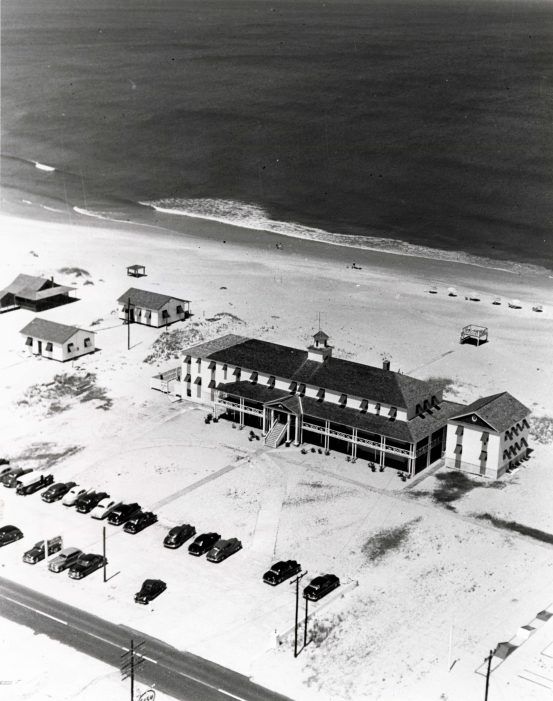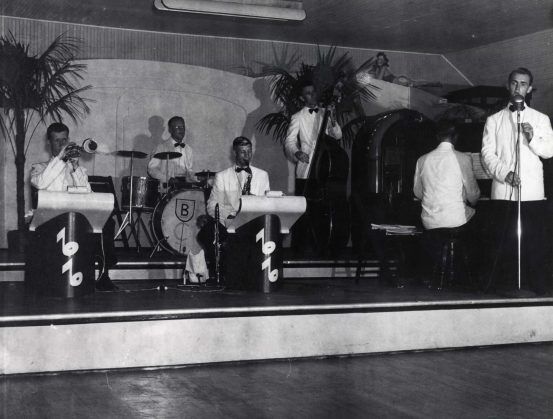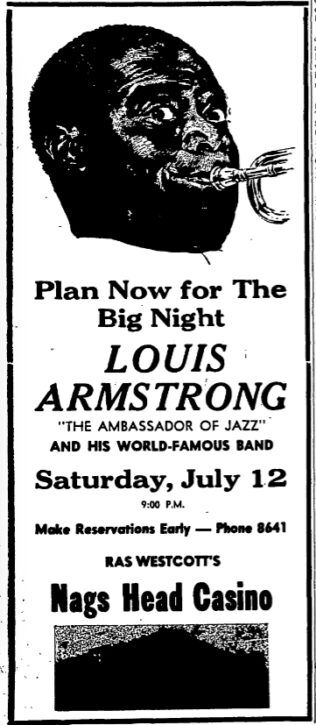On July 12, 1958, Louis Armstrong (Satchmo), arrived on the Outer Banks, and Ras Wescott’s Nags Head Casino was packed! By reputation, the top level dance floor held 1,000 people, and we can only imagine that there were more awaiting the performance of this legendary jazz musician.

It was a typical July summer night on the Outer Banks … hot, humid and sticky. There is no doubt that if the evening temperature was sweltering, Louis Armstrong and his All Star Band were even hotter. By all accounts, Armstrong’s visit to the Casino was a major highlight of this legendary Outer Banks night spot.
The building began life as a barracks for the stone masons who built the Wright Brothers Monument. When they departed, there wasn’t much use for a structure of that size on the Outer Banks. It became a boarding house for some time, but the facility only became successful when Wescott took over, installed a shimmering hardwood dance floor and created a legendary entertainment facility.
Opening in 1936, the Casino quickly became a local’s favorite hangout. A shrewd business man, Ras filled the downstairs with pinball machines, duck pins and a soda fountain to encourage wholesome family entertainment. Yet, it was the dance hall that brought visitors from as far away as Elizabeth City and Hampton Roads. According to numerous reports, the floor was polished and buffed to a high sheen with bowling alley wax. Shoes were forbidden, so guests danced to popular tunes in their stocking feet.

The Casino was popular from the onset, but it was likely WWII that created the spark that ignited the nightspot’s fame. With the war waging directly off the Outer Bank’s coastline (almost 400 ships were sunk within the sightlines of the North Carolina coast), there was an unprecedented numbers of service personnel on hand from Hatteras to Hampton Roads.

Soldiers and sailors hailing from all 48 states were residing locally and in search of nighttime activities, and Ras Wescott’s Nags Head Casino was the premiere location. Not surprising, there was some rowdiness. The Coastland Times, which was the only Outer Banks newspaper at the time, reported a number of incidents between law enforcement, the local population and military personnel. But by all accounts, these were minor hiccups at a time when most just wanted to find a way to enjoy themselves.
After WWII the music scene really picked up! Count Basie visited in 1951, and The Coastland Times reported, “Count Basie and his 16-piece orchestra drew a crowd of 1,000 to the Nags Head Casino Saturday night, June 2. It was the first nationally-famed orchestra to play at the Casion. Local dance fans found the Count to be just as reputed, the “Jump King of Swing, this was the first appearance Basie had make to the Dare Beaches, but it is hoped by May that he will return.”
Other national acts followed. Duke Ellington and Artie Shaw made the trip, and later when shag dancing and beach music came into vogue, Doug Clark and the Hot Nuts, Gene Vincent and Maurice Williams and the Zodiacs played at the casino by the sea.
Ras’ love was swing and dance music and as musical tastes changed, the Casino’s popularity waned. The Ash Wednesday Storm of 1962 severely damaged the building, and an aging Ras Wescott no longer had the energy to make a comeback. The property was sold in the mid-1970s and was eventually demolished to make room for what is now Kitty Hawk Kites and Jockey’s Ridge Crossing.
